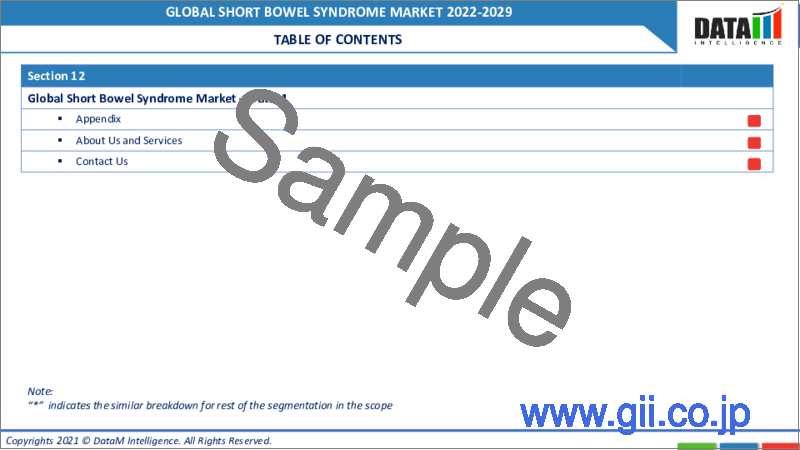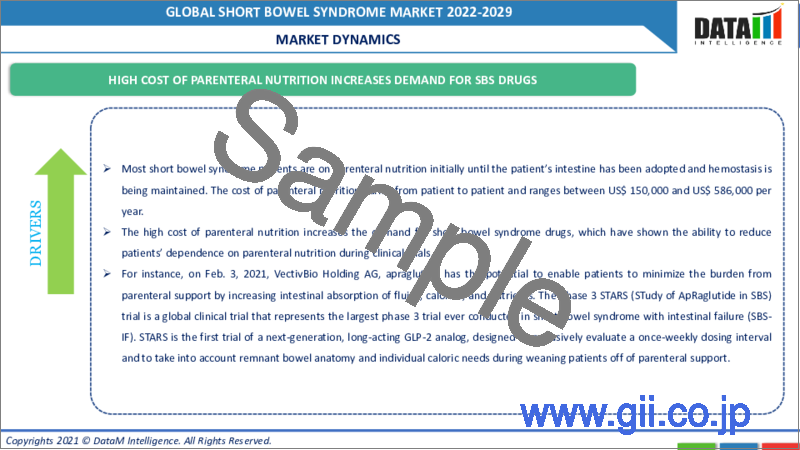|
|
市場調査レポート
商品コード
1107873
短腸症候群の世界市場(2022年~2029年)Global Short Bowel Syndrome Market - 2022-2029 |
||||||
|
● お客様のご希望に応じて、既存データの加工や未掲載情報(例:国別セグメント)の追加などの対応が可能です。 詳細はお問い合わせください。 |
|||||||
| 短腸症候群の世界市場(2022年~2029年) |
|
出版日: 2022年07月31日
発行: DataM Intelligence
ページ情報: 英文 180 Pages
納期: 約2営業日
|
- 全表示
- 概要
- 目次
世界の短腸症候群の市場規模は、予測期間(2022年~2029年)中に15.9%のCAGRで成長すると予想されています。
当レポートでは、世界の短腸症候群市場について調査分析し、市場力学、業界分析、市場分析、競合情勢など、体系的な情報を提供しています。
目次
第1章 世界の短腸症候群の調査手法と範囲
- 調査手法
- 調査の目的と調査範囲
第2章 世界の短腸症候群市場-市場の定義と概要
第3章 世界の短腸症候群市場-エグゼクティブサマリー
- 市場の内訳:薬剤クラス別
- 市場の内訳:流通チャネル別
- 市場の内訳:地域別
第4章 世界の短腸症候群市場-市場力学
- 市場に影響を与える要因
- 促進要因
- 非経口栄養の高コストによる短腸症候群薬の需要の高まり
- 抑制要因
- 高額な治療費
- 市場機会
- 影響分析
第5章 世界の短腸症候群市場-業界分析
- ポーターのファイブフォース分析
- サプライチェーン分析
- 価格分析
- 規制分析
- 特許分析
第6章 世界の短腸症候群市場におけるCOVID-19分析
- 市場におけるCOVID-19の分析
- COVID-19以前の市場シナリオ
- 現在のCOVID-19の市場シナリオ
- COVID-19後または将来のシナリオ
- COVID-19の中での価格の力学
- 需給スペクトル
- パンデミック時の市場に関連する政府の取り組み
- メーカーの戦略的イニシアチブ
- 結論
第7章 世界の短腸症候群市場:薬剤クラス別
- イントロダクション
- 市場規模分析と前年比成長率分析(%):薬剤クラス別
- 市場魅力指数:薬剤クラス別
- GLP-2*
- イントロダクション
- 市場規模分析、100万米ドル(2020年~2029年)、および前年比成長分析(%)(2021年~2029年)
- 成長ホルモン
- グルタミン
- その他
第8章 世界の短腸症候群市場:流通チャネル別
- イントロダクション
- 市場規模分析と前年比成長率分析(%):流通チャネル別
- 市場魅力指数:流通チャネル別
- 病院薬局*
- イントロダクション
- 市場規模分析、100万米ドル(2020年~2029年)、および前年比成長分析(%)(2021年~2029年)
- 小売薬局
- その他
第9章 世界の短腸症候群市場:地域別
- イントロダクション
- 市場規模分析、100万米ドル(2020年~2029年)、および前年比成長分析(%)(2021年~2029年):地域別
- 市場魅力指数:地域別
- 北米
- 欧州
- 南米
- アジア太平洋地域
- 中東とアフリカ
第10章 世界の短腸症候群市場-競合情勢
- 競合シナリオ
- 主な開発と戦略
- 企業シェア分析
- 製品のベンチマーク
- 注目すべき主要企業
- 破壊的技術を持つ企業
第11章 世界の短腸症候群市場-企業プロファイル概要
- Takeda Pharmaceutical Company Limited*
- OxThera Inc
- VectivBio AG
- Nutrinia
- Merck KGaA
- Pfizer Inc
- Ardelyx
- Zealand Pharma
- Nestle S.A
第12章 世界の短腸症候群市場-DataM
- 付録
- 当社・サービスについて
- 問い合わせ先
Market Overview
Short bowel syndrome market size was worth US$ XX million in 2021 and is estimated to reach US$ XX million by 2029, growing at a CAGR of 15.9 % during the forecast period (2022-2029).
Short bowel syndrome (SBS) is a metabolic disorder that occurs due to the malfunctioning or removal of the small intestine through surgery due to digestive illness. The consequences may be malabsorption, diarrhea, steatorrhea, fluid and electrolyte disturbances, and malnutrition.
Market Dynamics
The growth of the short bowel syndrome market is due to rise in global prevalence of GI disorders like volvulus, Inflammatory bowel disease (IBD), in particular, Crohn's disease (CD), which predisposes patients to development of SBS and mesenteric ischemia are the most common causes for SBS among all the age groups which demand the necessity of the treatment and high cost of parenteral nutrition increases demand for SBS drugs.
High cost of parenteral nutrition increases demand for SBS drugs is expected to hold the largest share in this market segment
Most of the short bowel syndrome patients are on parenteral nutrition initially until the patients' intestine has adopted and hemostasis is being maintained. The cost of parenteral nutrition varies from patient to patient, and ranges between US$ 150,000 and US$ 586,000 per year. High cost of parenteral nutrition increases the demand for short bowel syndrome drugs, which have shown the ability to reduce patient's dependence on parenteral nutrition during clinical trials.
For instance, Feb. 3, 2021, VectivBio Holding AG, apraglutide has the potential to enable patients to minimize the burden from parenteral support by increasing intestinal absorption of fluids, calories, and nutrients. The phase 3 STARS (STudy of ApRaglutide in SBS) trial is a global clinical trial that represents the largest phase 3 trial ever conducted in short bowel syndrome with intestinal failure (SBS-IF). STARS is the first trial of a next-generation, long-acting GLP-2 analog, designed to exclusively evaluate a once-weekly dosing interval and to take into account remnant bowel anatomy and individual caloric needs during weaning patients off of parenteral support.
High cost of treatment is likely to hamper the market growth
The cost of treatment of rare diseases is significantly high, which makes the treatment unaffordable for low-income groups. Additionally, lack of reimbursement in certain countries renders the treatment unreachable to several target group people.
For instance, in May 2019, the U.S. Food and Drug Administration (FDA) approved extending the indication of GITEX (teduglutide) for injection to pediatric patients 1 year of age and older with short bowel syndrome (SBS). Gattex (teduglutide) is an injectable drug used to treat adults with short bowel syndrome (SBS). Gattex is quite expensive, with treatment costing over US$ 295,000 a year. The cost of treatment for the lifetime renders the treatment unaffordable, as rare diseases are life-threatening and do not have a permanent cure, thereby leading to a decline in the number of patients preferring to avail the treatment.
COVID-19 Impact Analysis
Since patients with COVID-19 have reported gastrointestinal symptoms, such findings are creating additional revenue opportunities for manufacturers in the short bowel syndrome market. However, the SBS treatment requires long-term parenteral nutrition or an organ transplant. Hence, companies should collaborate with researchers to increase the study in autologous tissue engineering, which helps in treating an individual using their own cells or tissues. Companies are boosting their output capacities in anti-secretin agents to help patients reduce gastric acid in the intestine, growth hormones, and hypomotility agents to increase the time it takes the food to travel through intestines, resulting in increased nutrient absorption.
Segment Analysis
The GLP-2 drug therapy segment is expected to hold the largest share in this market segment
The GLP-2 drug treatment accounts for the major market share throughout the forecast period. The dominance is due to the only products available for treatment with the brand names Gattex and Revestive, introduced by Takeda which were approved for sales in both the US and Europe respectively. Also, the patent exclusivity of GLP-2 drug is anticipated to contribute to its significant share in the revenue of the global short bowel syndrome market.
For instance, Takeda Pharmaceuticals, on May 2019, announced that the US FDA approved extending the indication of GATTEX (teduglutide) for injection to pediatric patients 1 year of age and older with Short Bowel Syndrome (SBS) who need additional nutrition or fluids from intravenous (IV) feeding (parenteral support).
Geographical Analysis
North America region holds the largest market share of global short bowel syndrome market
North America is expected to major share of overall Short Bowel Syndrome Market throughout the forecast period. This dominance is mainly due to the revenue generated by the Gattex, the only glucagon-like peptide-2 (GLP-2) analog approved that improves intestinal absorption in patients with SBS in the U.S. Also, rise in the sedentary lifestyle that led no time to focus on nutritious and healthy food with increased consumption of unhealthy and junk food, resultant intestinal disorders are a major factor that drives the market growth in the region.
Competitive Landscape
The global short bowel syndrome market is moderately competitive with presence of local as well as global companies. Some of the key players which are contributing to the growth of the market include Takeda Pharmaceutical Company Limited, OxThera Inc, VectivBio AG, Nutrinia, Merck KGaA, Pfizer Inc, Ardelyx, Zealand Pharma and Nestle S.A. The major players are adopting several growth strategies such as product launches, acquisitions, and collaborations, which are contributing to the growth of the short bowel syndrome globally. For instance, In December 2020, 9 Meters Biopharma, Inc. announced positive topline results from its open-label phase 1b/2a clinical trial evaluating NM-002, its proprietary long-acting glucagon-like peptide-1 (GLP-1) receptor agonist in adults with short bowel syndrome (SBS). NM-002 is designed as a long-acting injectable GLP-1 receptor agonist that utilizes proprietary XTEN technology to extend circulating half-life. This is designed specifically to slow digestive transit time in SBS patients by reducing upper GI motility and improve the chronic diarrhea associated with a shortened intestine.
Key Companies to Watch
Takeda Pharmaceutical Company Limited
Overview: The Takeda Pharmaceutical Company Limited is a Japanese multinational pharmaceutical company, with partial American and British roots. It is the largest pharmaceutical company in Asia and one of the top 20 largest pharmaceutical companies in the world by revenue.
Product Portfolio: GATTEX (teduglutide) for subcutaneous injection is a prescription medicine used in adults and children 1 year of age and older with Short Bowel Syndrome (SBS).
Why Purchase the Report?
- Visualize the composition of the short bowel syndrome market segmentation by drug class, distribution channel, and region highlighting the key commercial assets and players.
- Identify commercial opportunities in short bowel syndrome market by analyzing trends and co-development deals.
- Excel data sheet with thousands of data points of short bowel syndrome market - level 4/5 segmentation.
- PDF report with the most relevant analysis cogently put together after exhaustive qualitative interviews and in-depth market study.
- Product mapping in excel for the key product of all major market players.
The global short bowel syndrome market report would provide an access to an approx. 47 market data table, 41 figures and 180 pages.
Target Audience
- Service Providers/ Buyers
- Industry Investors/Investment Bankers
- Education & Research Institutes
- Research Professionals
- Emerging Companies
- Manufacturers
Table of Contents
1. Global Short Bowel Syndrome Methodology and Scope
- 1.1. Research Methodology
- 1.2. Research Objective and Scope of the Report
2. Global Short Bowel Syndrome Market - Market Definition and Overview
3. Global Short Bowel Syndrome Market - Executive Summary
- 3.1. Market Snippet by Drug Class
- 3.2. Market Snippet by Distribution Channel
- 3.3. Market Snippet by Region
4. Global Short Bowel Syndrome Market - Market Dynamics
- 4.1. Market Impacting Factors
- 4.1.1. Drivers:
- 4.1.2. High cost of parenteral nutrition increases demand for SBS drugs
- 4.2. Restraints:
- 4.2.1. High cost of treatment
- 4.3. Opportunity
- 4.4. Impact Analysis
5. Global Short Bowel Syndrome Market - Industry Analysis
- 5.1. Porter's Five Forces Analysis
- 5.2. Supply Chain Analysis
- 5.3. Pricing Analysis
- 5.4. Regulatory Analysis
- 5.5. Patent Analysis
6. Global Short Bowel Syndrome Market - COVID-19 Analysis
- 6.1. Analysis of Covid-19 on the Market
- 6.1.1. Before COVID-19 Market Scenario
- 6.1.2. Present COVID-19 Market Scenario
- 6.1.3. After COVID-19 or Future Scenario
- 6.2. Pricing Dynamics Amid Covid-19
- 6.3. Demand-Supply Spectrum
- 6.4. Government Initiatives Related to the Market During Pandemic
- 6.5. Manufacturers Strategic Initiatives
- 6.6. Conclusion
7. Global Short Bowel Syndrome Market - By Drug Class
- 7.1. Introduction
- 7.1.1. Market Size Analysis, and Y-o-Y Growth Analysis (%), By Drug Class
- 7.1.2. Market Attractiveness Index, By Drug Class
- 7.2. GLP-2*
- 7.2.1. Introduction
- 7.2.2. Market Size Analysis, US$ Million, 2020-2029 and Y-o-Y Growth Analysis (%), 2021-2029
- 7.3. Growth Hormone
- 7.4. Glutamine
- 7.5. Others
8. Global Short Bowel Syndrome Market - By Distribution Channel
- 8.1. Introduction
- 8.1.1. Market Size Analysis, and Y-o-Y Growth Analysis (%), By Distribution Channel
- 8.1.2. Market Attractiveness Index, By Distribution Channel
- 8.2. Hospital Pharmacies*
- 8.2.1. Introduction
- 8.2.2. Market Size Analysis, US$ Million, 2020-2029 and Y-o-Y Growth Analysis (%), 2021-2029
- 8.3. Retail Pharmacies
- 8.4. Others
9. Global Short Bowel Syndrome Market - By Region
- 9.1. Introduction
- 9.1.1. Market Size Analysis, US$ Million, 2020-2029 and Y-o-Y Growth Analysis (%), 2021-2029, By Region
- 9.1.2. Market Attractiveness Index, By Region
- 9.2. North America
- 9.2.1. Introduction
- 9.2.2. Key Region-Specific Dynamics
- 9.2.3. Market Size Analysis, and Y-o-Y Growth Analysis (%), By Drug Class
- 9.2.4. Market Size Analysis, and Y-o-Y Growth Analysis (%), By Distribution Channel
- 9.2.5. Market Size Analysis, and Y-o-Y Growth Analysis (%), By Country
- 9.2.5.1. U.S.
- 9.2.5.2. Canada
- 9.2.5.3. Mexico
- 9.3. Europe
- 9.3.1. Introduction
- 9.3.2. Key Region-Specific Dynamics
- 9.3.3. Market Size Analysis, and Y-o-Y Growth Analysis (%), By Drug Class
- 9.3.4. Market Size Analysis, and Y-o-Y Growth Analysis (%), By Distribution Channel
- 9.3.5. Market Size Analysis, and Y-o-Y Growth Analysis (%), By Country
- 9.3.5.1. Germany
- 9.3.5.2. U.K.
- 9.3.5.3. France
- 9.3.5.4. Italy
- 9.3.5.5. Spain
- 9.3.5.6. Rest of Europe
- 9.4. South America
- 9.4.1. Introduction
- 9.4.2. Key Region-Specific Dynamics
- 9.4.3. Market Size Analysis, and Y-o-Y Growth Analysis (%), By Drug Class
- 9.4.4. Market Size Analysis, and Y-o-Y Growth Analysis (%), By Distribution Channel
- 9.4.5. Market Size Analysis, and Y-o-Y Growth Analysis (%), By Country
- 9.4.5.1. Brazil
- 9.4.5.2. Argentina
- 9.4.5.3. Rest of South America
- 9.5. Asia Pacific
- 9.5.1. Introduction
- 9.5.2. Key Region-Specific Dynamics
- 9.5.3. Market Size Analysis, and Y-o-Y Growth Analysis (%), By Drug Class
- 9.5.4. Market Size Analysis, and Y-o-Y Growth Analysis (%), By Distribution Channel
- 9.5.5. Market Size Analysis, and Y-o-Y Growth Analysis (%), By Country
- 9.5.5.1. China
- 9.5.5.2. India
- 9.5.5.3. Japan
- 9.5.5.4. Australia
- 9.5.5.5. Rest of Asia Pacific
- 9.6. Middle East and Africa
- 9.6.1. Introduction
- 9.6.2. Key Region-Specific Dynamics
- 9.6.3. Market Size Analysis, and Y-o-Y Growth Analysis (%), By Drug Class
- 9.6.4. Market Size Analysis, and Y-o-Y Growth Analysis (%), By Distribution Channel
10. Global Short Bowel Syndrome Market - Competitive Landscape
- 10.1. Competitive Scenario
- 10.2. Key Developments and Strategies
- 10.3. Company Share Analysis
- 10.4. Product Benchmarking
- 10.5. Key Companies to Watch
- 10.6. Company with disruptive technology
11. Global Short Bowel Syndrome Market- Company Profiles
- 11.1. Takeda Pharmaceutical Company Limited*
- 11.1.1. Company Overview
- 11.1.2. Product Portfolio and Description
- 11.1.3. Key Highlights
- 11.1.4. Financial Overview
- 11.2. OxThera Inc
- 11.3. VectivBio AG
- 11.4. Nutrinia
- 11.5. Merck KGaA
- 11.6. Pfizer Inc
- 11.7. Ardelyx
- 11.8. Zealand Pharma
- 11.9. Nestle S.A
LIST NOT EXHAUSTIVE
12. Global Short Bowel Syndrome Market - DataM
- 12.1. Appendix
- 12.2. About Us and Services
- 12.3. Contact Us




